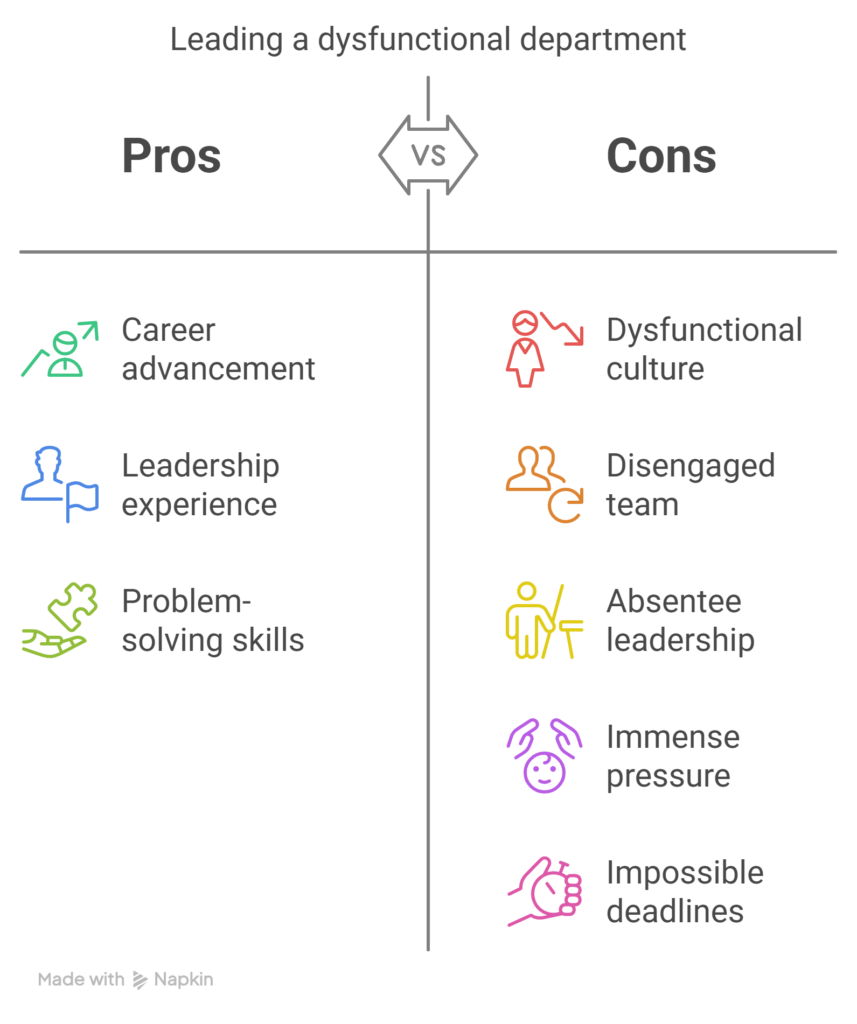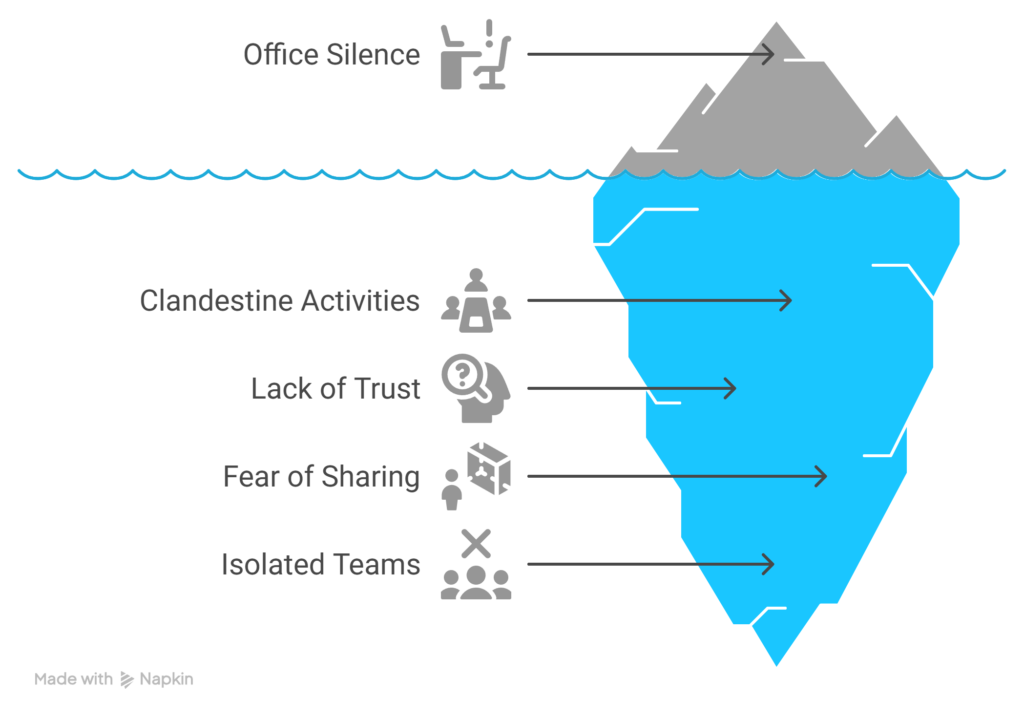Introduction
Imagine being an ambitious government officer at Gred 48, having just been transferred to a completely new department. The opportunity to lead a team in an unfamiliar area should have been the next step in a blossoming career—yet, the moment you step through the department’s doors, a chilling sense of dysfunction and disorder greets you. It feels less like a new beginning and more like a descent into chaos.

As you try to acclimate, every layer you peel back reveals another, deeper problem. The department’s culture is broken, the people disengaged, and the leadership absent. Yet, the pressure to deliver is immense. There are deadlines that seem impossible, and a head of department breathing down your neck. The situation creates a dilemma: how can you fix what is clearly falling apart, when the very people you need to rely on are contributing to the chaos? This case study delves into this complex dilemma faced by a Gred 48 officer who must decide how to proceed in an untenable situation.
The Arrival: An Unfamiliar Landscape
You arrive in the new department with an eagerness to prove yourself. However, it soon becomes apparent that this is no ordinary transfer. The area of work is entirely new to you—terms, procedures, and concepts you have never encountered before are now your responsibility. With only a few weeks to get up to speed, you dive headfirst into learning, hoping that your effort will compensate for your lack of expertise.

But learning isn’t your only challenge. You quickly notice that the team operates in silos. Everyone works in isolation, guarding their information as though it were gold. There is no communication, no collaboration. The more you try to bridge the gaps, the more it becomes clear that this is not just a misunderstanding or a minor flaw—it is a deeply embedded culture. The team’s members seem to live by the motto: “Keep your head down, and don’t get involved.”
The silence in the office is deafening. Conversations are minimal, and most of what happens feels clandestine, taking place behind closed doors. The absence of teamwork is disorienting, especially when you’re trying to understand your role and the inner workings of the department.

Endless Meetings: All Talk, No Action
Your first departmental meeting offers no solace. It’s a scene straight out of a nightmare. Everyone sits around the table, but there’s an atmosphere of inertia. The discussions are long, but the substance is shallow. People talk about the problems—endless issues that plague the department—but no one proposes a solution. As an outsider, you assume the silence is temporary, that someone will eventually break it with a viable plan. But they don’t.
You try to contribute, tentatively suggesting ideas or offering insights. Yet the room grows colder. Eyes turn away, body language shifts, and it becomes clear that any suggestion made will be met with resistance. The unspoken rule is clear: whoever suggests something must also be the one to implement it. Without support or resources, that person is left to struggle on their own. So, most people stay silent, and those who dare to speak quickly learn to stop.

By the end of your first week, you realise that every meeting follows the same pattern. Problems are identified, but no one is held accountable for solving them. As a result, nothing ever changes, and the cycle continues.
Pressure from Above
To make matters worse, your head of department demands results—fast. Despite the dysfunctional work environment, you’re expected to deliver high-quality output in a short timeframe. The head of department often reminds you, “There’s no time for excuses. We need this done now.” However, there’s little guidance on how to achieve these results in a department where no one seems to want to work together, and where responsibilities are passed around like a hot potato.
The pressure mounts daily. You feel like you’re being pushed toward an impossible task. Not only do you have to get up to speed in a new area, but you also have to fix the deep-rooted issues of a department that has lost its way. Meanwhile, your head of department doesn’t seem to acknowledge the challenges you’re facing. Instead, the focus remains squarely on deadlines and deliverables.

Subordinates Who Don’t Care
One of the most shocking discoveries is the indifference of your team. As their leader, you’re responsible for guiding them, but they seem utterly uninterested. Whether it’s apathy, burnout, or a learned helplessness from years of operating in a dysfunctional environment, you can’t quite tell.
You call for meetings with your direct reports, hoping to instill some sense of urgency or ownership, but their responses are lacklustre. When tasks are assigned, they are either half-heartedly completed or not done at all. They frequently arrive late to work or disappear for long periods.
After several attempts to motivate the team, you start to realise that this is not a problem you can solve with a simple pep talk. Your subordinates seem to have checked out mentally and emotionally from their jobs. It leaves you questioning your role as a leader: How can you inspire a team that doesn’t want to be inspired?
The Dilemma: To Speak or Not to Speak
As the pressure mounts, you start considering your options. On the one hand, you feel the need to speak up. The situation in the department is unsustainable, and without some drastic changes, it’s clear that you’ll be fighting a losing battle. Perhaps a candid conversation with the head of department could change things, or maybe bringing in external support could help address the siloed work culture and disengaged staff.
On the other hand, you’re aware of the risks. Speaking up could make you a target. If your head of department doesn’t take your concerns seriously, you might be labelled as a troublemaker or someone who’s not a “team player.” In a bureaucratic setting like the government, rocking the boat is often a career risk. You’ve heard stories of officers who tried to implement changes only to find themselves marginalised, with their requests ignored, their initiatives blocked.

You weigh the risks and benefits. Speaking up might lead to a positive outcome—it might break the cycle of dysfunction and give you the support you need to fix the department. But it might also backfire, isolating you even further and causing your team to become even more resistant.
Accountability: A Missing Element
Another dilemma presents itself. Accountability within the department is non-existent. No one seems to own their tasks. Finger-pointing is rampant. Whenever an issue arises, the immediate reaction is to assign blame to someone else. “It’s not my fault,” is a common refrain. Everyone is quick to absolve themselves of responsibility, leaving problems unresolved.
In one meeting, a critical document goes missing. When you ask for an explanation, no one steps forward. The silence in the room is telling—no one wants to admit to losing the document. It’s as though the problem will magically disappear if it’s ignored for long enough.
You realise that the department’s lack of accountability is not just a problem, it’s a symptom of the broader culture of avoidance. People are afraid to take ownership because they know that doing so might result in more work, more scrutiny, or more blame if things go wrong. How do you instill a sense of responsibility in a department that is used to shirking it? Should you implement stricter oversight, or would that only increase the level of resistance?

The Growing Divide: Head of Department vs. Team
Your relationship with the head of department becomes strained. The demands for quick results are growing more urgent, but the tools and resources you need to meet those demands are not forthcoming. Each time you request more time, more staff, or clearer guidance, you’re met with the same response: “Just get it done.”
At the same time, your team is becoming more distant. They see the pressure you’re under, but rather than rallying around you, they seem to withdraw even further. Perhaps they think you’re part of the problem, that you represent the same management culture that has made their work lives so difficult. Or maybe they’re simply too demoralised to care. Whatever the case, it’s clear that your team is no longer looking to you for leadership.

The Missing Pieces: Disengagement and Disappearing Acts
Every day brings a new challenge. One day, you notice that several key documents are missing. These are crucial files needed to complete a report for your head of department. You search everywhere, but they’re gone. When you ask your team about them, they claim ignorance. No one takes responsibility, and the clock is ticking.
Another day, two of your subordinates simply don’t show up for work. No notice, no explanation. They return the next day as though nothing happened. When you confront them, their response is casual: “I had something personal to take care of.” You’re stunned by the level of disengagement. How can you lead a team when half the time, they’re not even present?
The Ticking Clock: Decision Time
The deadline for your next major report is approaching fast. Your head of department has already made it clear that there will be no extensions. You’re under immense pressure, but your team is nowhere near ready to meet the deadline. Worse, your efforts to push them harder have only resulted in more absenteeism and resistance.
The pressure is becoming unbearable. Every day feels like a battle just to get the basics done, let alone deliver high-quality work. The finger-pointing, backstabbing, and constant avoidance of responsibility are taking a toll on your mental health. You know that something has to give, but you’re not sure what.
As you sit at your desk late one evening, reviewing the incomplete work and preparing for yet another tense meeting with the head of department, the question lingers.

Question 1: What are the key leadership challenges faced by the Gred 48 officer in this case study?
Rubric:
- 5 points: Clearly identifies and elaborates on multiple leadership challenges, including siloed work culture, lack of communication, disengaged subordinates, pressure from the head of department, lack of accountability, and absence of solutions in meetings. Provides examples and demonstrates an understanding of how these challenges affect the officer’s ability to lead effectively.
- 4 points: Identifies most of the leadership challenges with some elaboration but lacks depth in one or two areas. Shows a good understanding but may miss specific examples from the case.
- 3 points: Identifies a few key leadership challenges but provides only basic explanations with little or no examples from the case. Some challenges may be overlooked.
- 2 points: Struggles to identify leadership challenges or provides minimal explanations. Major challenges, such as pressure from the head of department, may be missing.
- 1 point: Fails to identify leadership challenges and provides inadequate or irrelevant explanations.
Question 2: How does the culture of finger-pointing and backstabbing contribute to the dysfunction within the department?
Rubric:
- 5 points: Thoroughly explains how the culture of finger-pointing and backstabbing undermines trust, destroys teamwork, and stifles accountability. Provides specific examples from the case, such as the missing documents and the avoidance of responsibility. Connects these issues to the overall lack of progress in the department.
- 4 points: Provides a good explanation of how finger-pointing and backstabbing contribute to dysfunction but lacks one or two specific examples or does not fully explore the impact on accountability.
- 3 points: Gives a basic explanation of how finger-pointing and backstabbing create issues but does not explore their full impact on the department. Limited or no examples provided.
- 2 points: A minimal or unclear explanation with no connection to accountability or department performance. Few or no relevant examples.
- 1 point: Fails to explain the role of finger-pointing and backstabbing in the dysfunction. Lacks clarity and examples.
Question 3: In the scenario, the Gred 48 officer is faced with a dilemma about whether to speak up or remain silent. What factors should they consider before making this decision?

Rubric:
- 5 points: Provides a comprehensive analysis of the factors to consider, such as the risk to their career, potential for change, lack of support from leadership, departmental culture, and the officer’s role in creating positive change. Discusses both the potential benefits and drawbacks of speaking up versus staying silent.
- 4 points: Identifies most relevant factors with some elaboration but may overlook certain aspects such as the impact on their team or the potential for personal risk. Addresses both sides of the dilemma.
- 3 points: Lists several factors but provides little analysis of how these factors weigh against one another. Might miss discussing either the benefits or the risks.
- 2 points: Mentions a few factors but with minimal depth or understanding of the complexity of the dilemma. May focus only on one aspect (e.g., personal risk) without considering others.
- 1 point: Fails to identify relevant factors, providing little insight into the officer’s dilemma. Lacks depth and critical analysis.
Question 4: What leadership strategies could the officer employ to encourage accountability and collaboration within the team?
Rubric:
- 5 points: Proposes several well-thought-out strategies such as setting clear goals, implementing accountability systems, promoting open communication, and creating opportunities for team collaboration. Each strategy is supported with examples from the case and explanations of how they would address specific issues within the department.
- 4 points: Proposes multiple strategies but lacks depth in one or two areas or may not tie the strategies directly to the case. Good understanding of how leadership can improve the situation.
- 3 points: Suggests a few strategies but provides only basic explanations of how they would work or lacks specific connections to the department’s issues. Limited discussion of accountability or collaboration.
- 2 points: Offers minimal or ineffective strategies with little explanation of how they would be implemented. The connection to the case is weak or unclear.
- 1 point: Fails to propose relevant strategies or does not address accountability and collaboration. Lacks connection to the case.
Question 5: If you were the Gred 48 officer, what would your next steps be to handle the pressure from the head of department while addressing the dysfunction within the team?

Rubric:
1 point: Fails to suggest clear next steps or provides inadequate strategies to address the officer’s situation.
5 points: Provides a detailed action plan with steps to manage the head of department’s expectations while initiating change within the team. The response balances the need for short-term results with long-term improvements in communication, accountability, and team morale. Clear prioritisation of tasks is shown.
4 points: Suggests a solid action plan with good strategies for managing the head of department’s pressure but lacks depth in either short-term or long-term solutions. Addresses the team’s dysfunction but not in full detail.
3 points: Provides a general action plan but with minimal elaboration on how to balance the head of department’s demands with team improvements. Focuses on one area (either head of department or team) but not both effectively.

2 points: Suggests a vague or unrealistic action plan, with little explanation of how the officer can manage both the pressure and the team’s issues. Lacks prioritisation.
